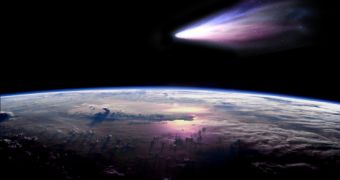A near-Earth asteroid dubbed Don Quixote that has been floating about in space for quite a while now is actually a comet, researchers at the Northern Arizona University say.
The scientific community became aware of the space rock's existence some 30 years ago. At that time, they did not find any evidence of cometary activity, so they quickly labeled it an asteroid, Newswise says.
More precisely, they argued that, judging by its orbit and appearance, Don Quixote used to be a comet that had lost all the carbon dioxide and water that formed its luminescent head and tail, and had therefore turned into a mere asteroid.
“Don Quixote's orbit resembles that of a comet, so people assumed it was a comet that had gotten rid of all its ice deposits thousands of years ago,” Michael Mommert, Ph.D, explains.
However, recent information obtained with the help of the Spitzer Space Telescope indicates that this space rock still packs a considerable amount of carbon dioxide and water ice.
This means that, contrary to popular opinion, Don Quixote is not a dead comet. On the contrary, it is very much alive. As Professor David Trilling puts it, evidence indicates that this celestial body is “sopping wet.”
The researchers now claiming that Don Quixote is a comet first started doubting the fact that the space rock was an asteroid back in 2009. At that time, they took some pictures of it and found that, for some reason, Don Quixote appeared brighter than expected.
However, these pictures were not very clear, so the scientists could not draw any conclusions concerning the nature of this celestial body.
Infrared images taken later on revealed that, much to the researchers' surprise, Don Quixote had not only a luminescent head, but also a faint tail. This indicated that it carried both carbon dioxide and water.
In fact, researchers say that, all things considered, this comet packs as much water as California's Lake Tahoe does, i.e. roughly 100 billion tons.
“This discovery of carbon dioxide emission from Don Quixote required the sensitivity and infrared wavelengths of the Spitzer telescope and would not have been possible using optical telescopes on the ground,” Michael Mommert stresses.
In light of these findings, scientists say that it might not be that far-fetched to assume that other near-Earth asteroids also carry large deposits of water ice and carbon dioxide.

 14 DAY TRIAL //
14 DAY TRIAL //